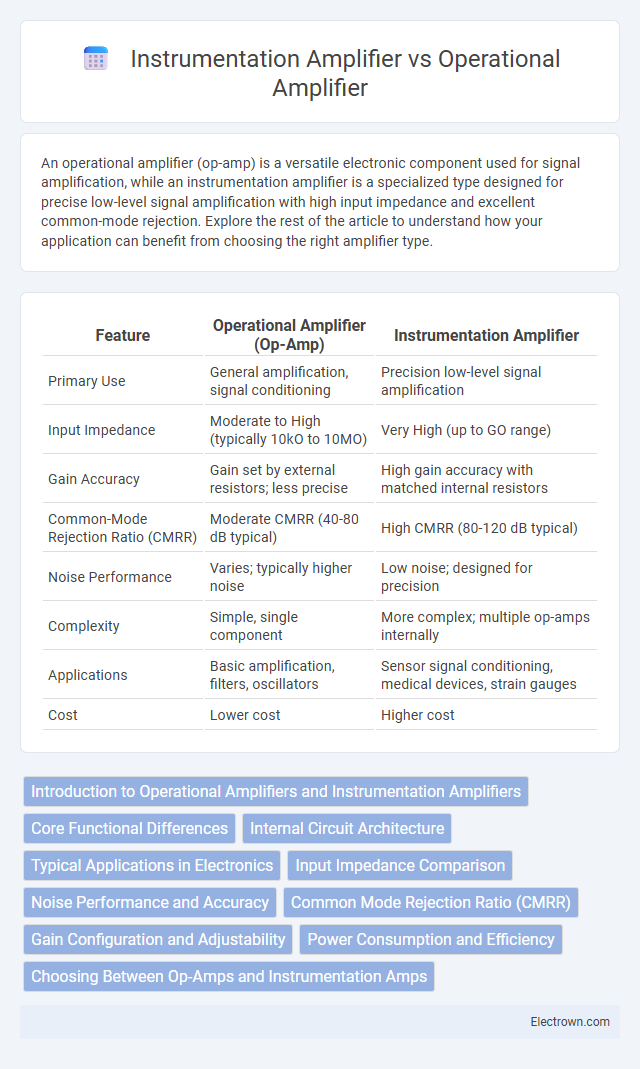An operational amplifier (op-amp) is a versatile electronic component used for signal amplification, while an instrumentation amplifier is a specialized type designed for precise low-level signal amplification with high input impedance and excellent common-mode rejection. Explore the rest of the article to understand how your application can benefit from choosing the right amplifier type.
Table of Comparison
| Feature | Operational Amplifier (Op-Amp) | Instrumentation Amplifier |
|---|---|---|
| Primary Use | General amplification, signal conditioning | Precision low-level signal amplification |
| Input Impedance | Moderate to High (typically 10kO to 10MO) | Very High (up to GO range) |
| Gain Accuracy | Gain set by external resistors; less precise | High gain accuracy with matched internal resistors |
| Common-Mode Rejection Ratio (CMRR) | Moderate CMRR (40-80 dB typical) | High CMRR (80-120 dB typical) |
| Noise Performance | Varies; typically higher noise | Low noise; designed for precision |
| Complexity | Simple, single component | More complex; multiple op-amps internally |
| Applications | Basic amplification, filters, oscillators | Sensor signal conditioning, medical devices, strain gauges |
| Cost | Lower cost | Higher cost |
Introduction to Operational Amplifiers and Instrumentation Amplifiers
Operational amplifiers (op-amps) are versatile electronic components widely used for signal amplification, featuring high gain and differential inputs. Instrumentation amplifiers build upon op-amps, offering enhanced precision, high input impedance, and excellent common-mode rejection ideal for accurate low-level signal measurement. Your choice between these amplifiers depends on the required signal fidelity, noise reduction, and application complexity.
Core Functional Differences
Operational amplifiers (op-amps) are versatile voltage amplifiers primarily designed for signal amplification, filtering, and mathematical operations, with a single-ended input stage. Instrumentation amplifiers consist of multiple op-amps configured to provide high input impedance, precise gain, and excellent common-mode rejection ratio (CMRR), making them ideal for differential signal amplification in noisy environments. The core functional difference lies in the instrumentation amplifier's ability to amplify low-level differential signals accurately while rejecting common-mode interference, unlike standard operational amplifiers.
Internal Circuit Architecture
Operational amplifiers feature a simple internal architecture consisting of differential input stages, gain stages, and output buffers, optimized for general amplification tasks. In contrast, instrumentation amplifiers integrate multiple operational amplifiers with precision resistor networks in their internal circuit design, providing high input impedance, low offset voltage, and superior common-mode rejection ratio (CMRR). Understanding the internal circuit architecture of these amplifiers helps you select the appropriate device for applications requiring precise, low-noise signal amplification.
Typical Applications in Electronics
Operational amplifiers are widely used in signal conditioning, filtering, and analog computing due to their versatility and high gain characteristics. Instrumentation amplifiers excel in precision measurement applications such as medical instrumentation, industrial process controls, and sensor data acquisition, where accurate low-level signal amplification with high common-mode rejection is critical. Your choice depends on the need for precision and noise rejection versus general-purpose signal amplification.
Input Impedance Comparison
Instrumentation amplifiers typically offer significantly higher input impedance compared to operational amplifiers, often reaching megaohms to gigaohms, which minimizes signal loading and preserves signal integrity. Operational amplifiers usually have lower input impedance, making them less ideal for accurate measurement of high-impedance sources. Your choice between the two should consider the need for high input impedance to ensure precise and noise-resistant amplification in sensitive signal applications.
Noise Performance and Accuracy
Instrumentation amplifiers exhibit superior noise performance and accuracy compared to operational amplifiers by utilizing three op-amps to achieve high input impedance and low output impedance, minimizing signal degradation. Their precise gain control and differential input configuration significantly reduce common-mode noise and interference, making them ideal for sensitive measurements. Operational amplifiers, while versatile, often require additional components for noise reduction and may not match the low offset voltage and high CMRR (Common-Mode Rejection Ratio) inherent in instrumentation amplifiers.
Common Mode Rejection Ratio (CMRR)
Operational amplifiers typically have a lower Common Mode Rejection Ratio (CMRR) compared to instrumentation amplifiers, which are specifically designed for high CMRR performance. Instrumentation amplifiers utilize precision matched resistors and differential input stages to achieve CMRR values often exceeding 100 dB, essential for extracting small differential signals in noisy environments. This superior CMRR makes instrumentation amplifiers ideal for applications requiring accurate measurement of low-level signals in the presence of significant common-mode noise.
Gain Configuration and Adjustability
Operational amplifiers offer flexible gain configuration through external resistor networks, allowing wide-range gain adjustment but require careful design to maintain accuracy. Instrumentation amplifiers feature built-in gain adjustment with precise resistor matching, providing high input impedance and stable gain ideal for accurate low-level signal amplification. The gain of instrumentation amplifiers is easily set by a single external resistor, enhancing repeatability and minimizing errors compared to the more variable gain settings of standard operational amplifier circuits.
Power Consumption and Efficiency
Instrumentation amplifiers typically consume more power than operational amplifiers due to their internal multi-amplifier architecture designed for precise differential signal measurement. Operational amplifiers offer higher efficiency in low-power applications as they generally contain fewer active components and simpler circuitry. Selecting between the two depends on the trade-off between power consumption and the need for accurate, low-noise amplification in specific signal conditioning tasks.
Choosing Between Op-Amps and Instrumentation Amps
Choosing between operational amplifiers and instrumentation amplifiers depends on your application's need for precision and noise rejection. Instrumentation amplifiers offer superior input impedance, excellent common-mode rejection ratio (CMRR), and stable gain, making them ideal for accurate low-level signal amplification in medical or industrial sensor measurements. Operational amplifiers are versatile and cost-effective for general-purpose amplification but may require additional components to match the performance of instrumentation amps in high-precision scenarios.
operational amplifier vs instrumentation amplifier Infographic

 electrown.com
electrown.com